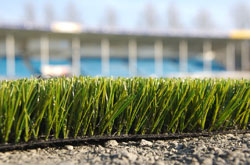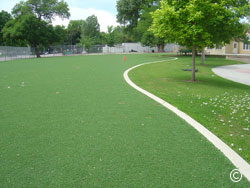Artificial turf has been traditionally installed in high-use athletic field facilities. The “new generation” artificial turf is quite different from the old hard and unsafe  AstroTurf® of the 1970’s and ’80’s. The new artificial turf consists of a loose pile carpet of grass-like fibers. This is “infilled” or topdressed with rubber granules from recycled tires, athletic shoes, or other rubber sources, sometimes in combination with sand.
AstroTurf® of the 1970’s and ’80’s. The new artificial turf consists of a loose pile carpet of grass-like fibers. This is “infilled” or topdressed with rubber granules from recycled tires, athletic shoes, or other rubber sources, sometimes in combination with sand.
In addition to the installation costs—that range from 4 to 10 dollars per square foot—consider environmental impacts when using this product in a traditional landscape. Because it is not a living, transpiring plant, artificial turf does not provide the cooling effect of a living lawn and becomes quite warm on a sunny day. On hot days, there is often a distinct hot rubber odor. The carpet/topdressing combination does allow water to infiltrate underlying soil. There is no research to document effects on soil microbes, earthworms, or insects or to the health of landscape plants with roots growing under the carpet.
The companies that sell and install these lawns insist that they are virtually maintenance free, but artificial turf collects leaves and other wind-blown d irt and debris that must somehow be removed. Pet feces and urine deposits are problematic. These artificial surfaces do not naturally disinfect themselves by biological means like a living lawn does. Although artificial turf does not require mowing, fertilizing, or watering and can be a legitimate solution for high traffic sites, it fails to provide the traditional landscape with the many environmental benefits of living grass.
irt and debris that must somehow be removed. Pet feces and urine deposits are problematic. These artificial surfaces do not naturally disinfect themselves by biological means like a living lawn does. Although artificial turf does not require mowing, fertilizing, or watering and can be a legitimate solution for high traffic sites, it fails to provide the traditional landscape with the many environmental benefits of living grass.
For more information, see the following Planttalk Colorado™ script(s).



